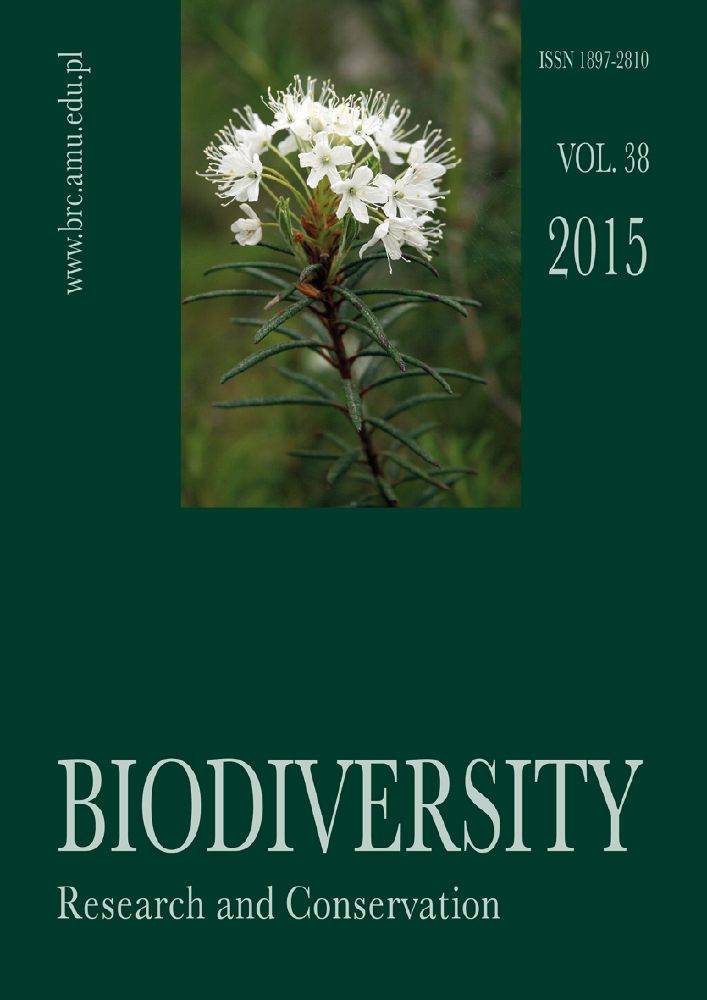Abstract
Gravel bars are the initial habitats, inseparably connected to the mountain streams. On the one hand, they are an unstable substrate, influenced by the overflows and high waters; however, they are also exposed to strong sunlight and heat. This situation determines specific vegetation which, due to dynamic changes in the habitat, has a pioneer character. What is more, gravel bars are areas where many river migratory species and many random species appear. Among them, there are also synanthropic species. In years 2011-2012, floristic and phytosociological studies were conducted in the Silesian Beskids. The goal of these studies was to recognize the vegetation of the gravel bars of the Vistula and the Brennica rivers - from their springs in the Silesian Beskids to the point where the Brennica River flows into the Vistula River in the Silesian Foothills. The studied section of the two rivers is regulated. Particular attention was paid to the synanthropic species that pose a threat to the native flora. In 9 recognized types of plant communities, 293 vascular plant species were recognized. More than 15% of the flora were alien species (45) and 22 of them were considered to be invasive. The most common invasive species that were spotted included: Impatiens glandulifera, Heracleum mantegazzianum and Reynoutria japonica. Plant communities with the biggest number and share of alien species were Plantago major-Barbarea vulgaris community and Phalaridetum arundinaceae.
References
Balezentiene L. & Renco M. 2014. Phytotoxicity and accumulation of secondary metabolites in Heracleum mantegazzianum (Apiaceae). Allelopathy Journal 33(2): 267-276.
Braun-Blanquet J. 1964. Pflanzensoziologie, Grundzuge der Vegetationskunde. 3 Aufl. 865 pp. Springer Verlag, Wien-New York.
Chittka L. & Schürkens S. 2001. Successful invasion of a floral market: an exotic plant has moved in on Europe’s river banks by bribing pollinators. Nature 411: 653.
Chmura D., Tokarska-Guzik B., Nowak T., Woźniak G., Bzdęga K., Koszela K. & Gancarek M. 2015. The influence of invasive Fallopia taxa on resident plant species in two river valleys (southern Poland). Acta Soc. Bot. Pol. 84(1): 23-33.
Dajdok Z., Anioł-Kwiatkowska J. & Kącki Z. 1998. Impatiens glandulifera Royle in the floodplain vegetation of the Odra River (Western Poland). In: U. Starfinger, K. Edwards, I. Kowarik & M. William son (eds.). Plant Invasions: Ecological Mechanisms and Human Responses, pp. 161-168, Backhuys Publishers, Leiden, the Netherlands.
Dubiel E., Stachurska A. & Gawroński S. 1999. Nieleśne zbiorowiska roślinne Magurskiego Parku Narodowego (Beskid Niski). Prace Botaniczne UJ 33: 1-60.
Grodzińska K. 1979. Mapa zbiorowisk roślinnych rezerwatu Przełomu Białki pod Krempachami (Pieniński Pas Skałkowy). Ochr. Przyr. 42: 29-70.
Hejda M. & Pyšek P. 2006. What is the impact of Impatiens glandulifera on species diversity of invaded riparian vegetation? Biological Conservation 132: 143-152.
Kamycka Z. 2013. Zróżnicowanie roślinności żwirowisk i kamieńców Wisły i Brennicy w Beskidzie Śląskim, MSc Thesis, Department of Ecology, University of Silesia, Katowice, Poland.
Kornaś J. & Medwecka-Kornaś A. 1967. Zespoły roślinne Gorców. I. Naturalne i na wpół naturalne zespoły nieleśne. Fragm. Flor. Geobot. 13: 167-318.
Koczur A. 1999. Godny ochrony odcinek doliny Czarnego Dunajca. Chrońmy Przyr. Ojcz. 55(3): 39-50.
Matuszkiewicz W. 2008. Przewodnik do oznaczania zbiorowisk roślinnych Polski. In: J. B. Faliński (ed.). Vademecum Geobotanicum 3, 537 pp. Wyd. Nauk. PWN, Warszawa.
Mirek Z., Piękoś-Mirkowa H., Zając A. & Zając M. 2002. Flowering plants and pteridophytes of Poland. A checklist. In: Z. Mirek (ed.). Biodiversity of Poland, 1, 442 pp. W. Szafer Institute of Botany, Polish Academy of Sciences, Kraków.
Moravcová L., Pyšek P., Jarošík V. & Zákravský P. 2011. Potential phytotoxic and shading effects of invasive Fallopia (Polygonaceae) taxa on the germination of dominant native species. NeoBiota 9: 31-47.
Nehrbass N., Winkler E, Pergl J., Perglová I. & Pyšek P. 2006. Empirical and virtual investigation of the population dynamics of an alien plant under the constraints of local carrying capacity: Heracleum mantegazzianum in the Czech Republic. Perspectives in Plant Ecology, Evolution and Systematics 7: 253-262.
Pawłowski B. 1972. Skład i budowa zbiorowisk roślinnych oraz metody ich badania. In: W. Szaf er & K. Zarzycki (eds.). Szata roślinna Polski, I, pp. 237-269. PWN, Warszawa.
Piękoś-Mirkowa H. & Mirek Z. 1996. Zbiorowiska roślinne. In: Z. Mirek (ed.). Przyroda Tatrzańskiego Parku Narodowego, pp. 237-274. Tatrzański Park Narodowy, Kraków-Zakopane.
Śliwiński M. & Anioł-Kwiatkowska J. 2011. Rozprzestrzenianie się Heracleum sosnowskyi Manden. i Heracleum mantegazzianum Sommier & Levier (Apiaceae) w aglomeracji wrocławskiej. Bad. Fizjogr., seria B - Botanika 2(60): 151-163.
Tokarska-Guzik B., Dajdok Z., Zając M., Zając A., Urb isz A., Danielewicz W. & Hołdyński C. 2012. Rośliny obcego pochodzenia w Polsce ze szczególnym uwzględnieniem gatunków inwazyjnych. 197 pp. GDOŚ, Warszawa.
Uziębło A. K & Ciapała S. 2006. Zróżnicowanie florystyczne i ekologiczne roślinności przypotokowej w masywie Babiej Góry. Ochrona Beskidów Zachodnich 1: 93-103.
Uziębło A. K. & Skowronek I. 2008. Penetration of anthropophytes into alluvial phytocoenoses of the Skawica river valley (western Carpathians). Biodiv. Res. Conserv. 9-10: 43-50.
Vrchotová N., Šerá B. & Krejčová J. 2011. Allelopathic activity of extracts from Impatiens species. Plant Soil Environ. 57(2): 57-60.
Yoshikawa M., Hoshino Y. & Iwata N. 2013. Role of seed settleability and settling velocity in water for plant colonization of river gravel bars. Journal of Vegetation Science 24: 712-723.
Zarzycki K. 1956. Zarastanie żwirowisk Skawicy i Skawy. Fragm. Flor. Geobot. 2(1): 111-142.




